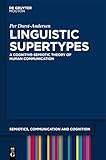Linguistic Supertypes : A Cognitive-Semiotic Theory of Human Communication / Per Durst-Andersen.
Material type: TextSeries: Semiotics, Communication and Cognition [SCC] ; 6Publisher: Berlin ; Boston : De Gruyter Mouton, [2011]Copyright date: ©2012Description: 1 online resource (314 p.)Content type:
TextSeries: Semiotics, Communication and Cognition [SCC] ; 6Publisher: Berlin ; Boston : De Gruyter Mouton, [2011]Copyright date: ©2012Description: 1 online resource (314 p.)Content type: - 9783110253139
- 9783110253153
- 302.201 22/ger
- P99 .D88 2011eb
- online - DeGruyter
- Issued also in print.
| Item type | Current library | Call number | URL | Status | Notes | Barcode | |
|---|---|---|---|---|---|---|---|
 eBook
eBook
|
Biblioteca "Angelicum" Pont. Univ. S.Tommaso d'Aquino Nuvola online | online - DeGruyter (Browse shelf(Opens below)) | Online access | Not for loan (Accesso limitato) | Accesso per gli utenti autorizzati / Access for authorized users | (dgr)9783110253153 |
Browsing Biblioteca "Angelicum" Pont. Univ. S.Tommaso d'Aquino shelves, Shelving location: Nuvola online Close shelf browser (Hides shelf browser)
Frontmatter -- Contents -- Preface -- Part I: Language and beyond -- Chapter 1. Language and situations -- Chapter 2. Language and perception -- Chapter 3. Language and cognition -- Part II: Grammar and communication -- Chapter 4. Grammar and pragmatics -- Chapter 5. Grammar and semiotics -- Part III: Language inside out -- Chapter 6. From types to supertypes -- Chapter 7. The basic voice of language -- Chapter 8. Linguistic expansion -- Chapter 9. The principal and secondary voice of language -- Focusing summary -- References -- Definition list -- Index
restricted access online access with authorization star
http://purl.org/coar/access_right/c_16ec
The book offers a completely new view of language and of languages such as Russian, Chinese, Bulgarian, Georgian, Danish and English by dividing them into three supertypes on the basis of a step-by-step examination of their relationship to perception and cognition, their representation of situations and their use in oral and written discourse. The dynamic processing of visual stimuli involves three stages: input (experience), intake (understanding) and outcome (a combination). The very choice among three modalities of existence gives a language a certain voice -- either the voice of reality based on situations, the speaker's voice involving experiences or the hearer's voice grounded on information. This makes grammar a prime index: all symbols are static and impotent and need a vehicle, i.e. grammar, which can bring them to the proper point of reference. Language is shown to be a living organism with a determinant category, aspect, mood or tense, which conquers territory from other potential competitors trying to create harmony between verbal and nominal categories. It is demonstrated that the communication processes are different in the three supertypes, although in all three cases the speaker must choose between a public and a private voice before the grammar is put into use.
Issued also in print.
Mode of access: Internet via World Wide Web.
In English.
Description based on online resource; title from PDF title page (publisher's Web site, viewed 28. Feb 2023)









